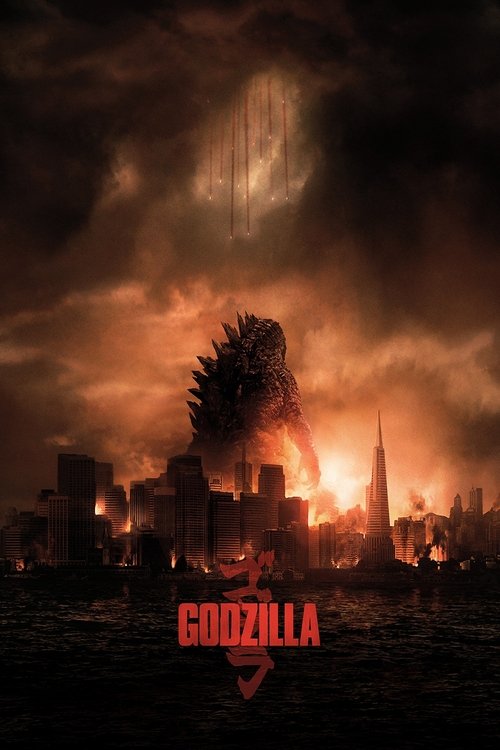RG
Roberto Giacomelli
•In a cave in the Philippines, a strange fossil is found that looks like a chrysalis, along with unsettling and gigantic bones that don't seem to belong to any known prehistoric animal. The chrysalis is brought to Japan for analysis, but something inside it appears to be alive and ready to emerge. The danger is swiftly averted thanks to Professor Joseph Brody and his wife and colleague Sandra.
Fifteen years later, the situation seems to repeat itself. The chrysalis, kept under close watch, has absorbed a great deal of energy and appears ready to hatch. When Dr. Serizawa orders the elimination of the creature inside, he instead facilitates its birth, and despite all security measures, a gigantic insect-like being escapes in search of nourishment, drawn to nuclear energy. At the same time, another creature, much larger and more destructive, emerges from the depths of the Pacific Ocean, causing a devastating tsunami. This latter creature is well known to the military: it is Godzilla, a being older than the dinosaurs, awakened by the atomic disaster of Hiroshima in 1949 and who had already sown panic in Japan during the 1950s. Now, Godzilla is hunting the other monster, which the military has nicknamed M.U.T.O., and appears to be heading toward San Francisco.
With over 30 films, the "Godzilla" saga is among the longest-running in cinema history, standing as an unparalleled symbol not only of the monster movie genre, but also within a specific cinematic tradition—Japanese cinema. The first film dedicated to the King of Monsters dates back to 1954, produced by Toho Co. and directed by the legendary Ishiro Honda; the latest was in 2004, "Gojira – Final Wars" by Ryuhei Kitamura (while the last to arrive in Italy was "Godzilla vs Mothra" from 1992). In the meantime, there was also an American remake in 1998 directed by Roland Emmerich, who unfortunately decided to radically change the look of the radioactive lizard and much of its mythology and traits, resulting in the disdain of fans and a flop at the box office. Now the US tries again, with Legendary Pictures taking the reins—last year they produced another monster movie, the stunning "Pacific Rim" by Guillermo Del Toro, which paid homage to Japanese fantasy imagery. The risky task of rebooting this colossal icon falls to British director Gareth Edwards, who made a name for himself in 2010 with a low-budget monster movie, the interspecies gem "Monsters".
Fans approach this new American version of the Japanese myth with caution; despite a director who inspires confidence, a production company that has already shown skill in handling the genre, and the presence of TV's Heisenberg, Bryan Cranston, the sting of the previous American Godzilla film is still fresh.
But we can breathe a sigh of relief, because Gareth Edwards's "Godzilla" is a surprising film—an intelligent, respectful spectacle full of personality: a masterpiece for its genre!
The 1954 "Godzilla" was born from specific cultural needs—a deeply personal response to the American monster movies that had just found success with the beautiful "The Beast from 20,000 Fathoms" (1953) by Eugène Lourié. Japan still bore the fresh radioactive wound of the H-bomb that leveled Hiroshima and Nagasaki only a few years earlier, which provided the perfect backdrop for a fantastic story that would exorcise lingering fears. Godzilla was born from this, from atomic fear, as the personification of radioactive destruction—the catalyst for a people's pain, drawing strength from recent trauma. Over the years, Godzilla has become a symbol of the nation, a pop icon, and from a terrifying force, he became a precious ally—a guardian of the eastern island against external threats, which invariably took the form of his monstrous kin.
Gareth Edwards, aware of this legacy, directs Max Borenstein's screenplay with almost sacred respect, making his "Godzilla" not only a reboot for new generations but also a true sequel to the Toho films (at least the early ones). The human characters in "Godzilla" already know the monster from what happened in 1954, and thus aren't particularly surprised by his presence; they know his destructive potential, but at the same time trust in his power to save. This is especially evident in the perspective of Ken Watanabe's character, who compares the radioactive lizard to a deity and understands that the only way to defeat the M.U.T.O. parasites is to let them fight Godzilla, because he is a guardian, risen from the depths to restore balance to the earth. This eastern, almost zen viewpoint is perfectly balanced with the more American (science-)fiction component, which presents Godzilla as an ancient predator drawn to radioactivity, awakened by the atom in '49, then dwelling in the ocean depths close to the earth's core, and finally lured by parasites with their mating calls.
If the first half hour of the film is pure setup, once the monsters appear, the entertainment is worthy of a standing ovation. Godzilla's entrance, initially only hinted at with masterful directorial choices that build mystery, is simply thrilling—applause-worthy. The creature's look is faithful to tradition (even if its size has increased considerably), and as a result, appears as one of the most beautiful monsters ever seen on the big screen. The M.U.T.O.s also have an appealing design, though less original (one in particular recalls the monster from "Cloverfield"), and what fascinates most is their primordial motivation, which gives Edwards a moment to self-reference "Monsters" in a scene that, paradoxically, can be described as very tender.
"Godzilla" also features human characters, who understandably take a back seat. There's Aaron Taylor-Johnson from "Kick-Ass" as the protagonist, a young soldier with a family who comes across as more realistic and empathetic than most of his counterparts; his wife, played by the always excellent Elizabeth Olsen, is perhaps more marginal than expected; and then there's Bryan Cranston, now a major star thanks to the masterpiece series "Breaking Bad", who brings his usual professional presence and leaves a stronger impression than his co-stars.
But "Godzilla" bears its name because the true protagonist is him—the King of Monsters who destroys buildings, kills monsters, breathes radioactive fire, references King Kong, and in the final moments even manages to move the viewer, who inevitably roots for him throughout the film.
"Godzilla" is a magnificent fresco of fantasy cinema, an homage to the most important monster movie in history, and at the same time, a new and effective beginning.
Godzilla lives. Long live Godzilla!
Watch the GODZILLA trailer










